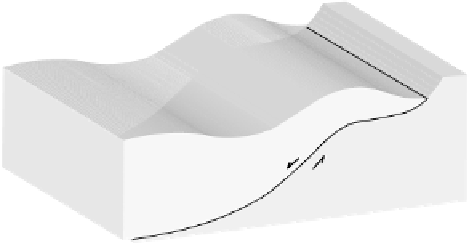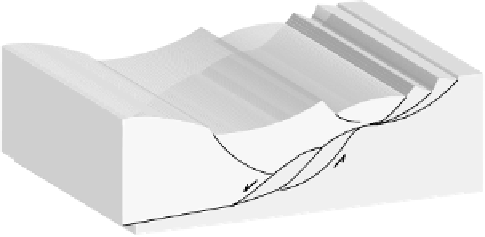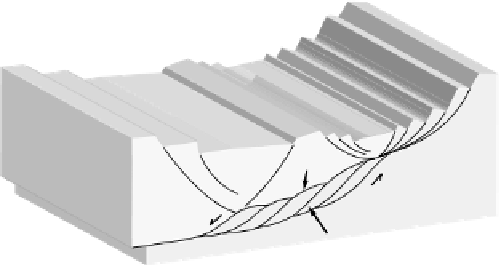Geoscience Reference
In-Depth Information
(a)
Flat
HWB
FWB
Ramp
(b)
Detachment fault
Horses
(c)
RF
FF
Extensional duplex
Fig. 4.104
Progressive deformation of the hangingwall block (HWB) in a normal listric fault with a ramp and detachment. (a) Bending of the
hanging wall to adjust to fault surface geometry. (b) The ramp migrates as extension takes place giving way to a set of imbricated sigmoidal
slices called horses (b) in the footwall block (FWB). These form together with a duplex structure at depth and a series of secondary faults in
the hanging wall, defining a complex half graben with normal listric faults forming a fan (b and c). Duplex structures are bounded by two
faults, the roof fault (RF) at the top and the foot fault at the bottom (FF).
thrust belts are highly asymmetrical in the direction of
tectonic transport or general displacement, and generally
most faults dip toward the hinterland. Locally thrust faults
can form in compressive reaches of gravitational slides
developed at the foot of the collapsing rock masses or other
processes related to folding or igneous intrusive processes.
Reverse faults are high-angle faults, showing surfaces
inclined as much as normal faults greater than or equal to
60
compression regimes, and reactivation of previous gener-
ated normal faults as reverse faults. Also the curving at depth
of the stress axis directions, or
stress trajectories
, can produce
curved fault surfaces allowing thrust faults to evolve to
reverse faults at depth and also for thrusts to evolve to high-
angle faults by frontal ramping to the surface (Fig. 4.106).
Diverging stress trajectories can be produced if stress gradi-
ents and differences in the state of stress exists both in the
vertical and lateral directions. Thrusts generally are initiated
as low-angle faults but can be subsequently deformed by
compression changing the overall shape.
Compressive tectonic settings can display very complex
structures with thrusts, reverse faults, and folds associated
together. This style of deformation is known as
thin-
skinned tectonics
because a relatively thin layer of the crust
suffers intense shortening and deformation whereas the
. They are not as common as thrusts but can be impor-
tant features in many tectonic compressive settings.
However they do not fit Anderson's theory of faulting in
which faults formed by horizontal compression should be
low-angled. Also, considering Anderson's stress conditions,
reverse faults do not follow Coulomb's failure criterion
either. Several explanations for the formation of high-angle
reverse faults include tectonic inversion from extension to

















Search WWH ::

Custom Search